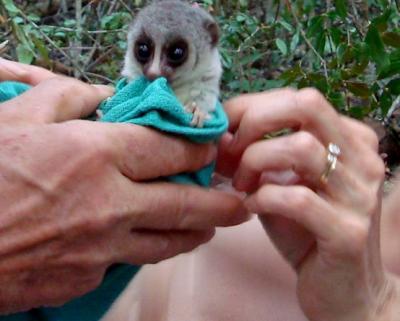Fat-tailed dwarf lemurs are the only primates that hibernate - and their sleep patterns during hibernation are different from other animals that hibernate, like ground squirrels, which also hibernate at similar temperatures.
During hibernation, dwarf lemurs experience periods of rapid eye movement (REM) sleep at relatively high ambient temperatures, but no non-REM sleep. Ground squirrels, by contrast, experience only periods of non-REM sleep at high temperatures.
The sleep patterns observed confirm a link between ambient temperature while sleeping and metabolic rate.

During hibernation, non-REM sleep is absent in the lemuriform primate Cheirogaleus medius. Credit: Mackenzie Wing
Lead author Andrew D. Krystal , from the Department of Psychiatry and Behavioral Sciences at Duke University School of Medicine, said "We carried out the first brain electrical activity recordings in a hibernating primate and found ultra-low voltage signals during hibernation at lower ambient temperatures indicative of minimal brain activity, but at higher ambient temperatures we observed brain activity and eye movements suggestive of a REM Sleep like state.
"The findings: 1) suggest that hibernation is not a state of dormancy but that sleep may occur; 2) confirm a link between temperature, metabolic rate, and sleep; and; 3) indicate that the fat-tailed dwarf lemur may serve as an alternative model for studying sleep, temperature, and metabolism which may be uniquely relevant to understanding human physiology and improving treatments for conditions such as obesity, traumatic injury, stroke, and rabies."
The results also suggest that the relationship between sleep stages, temperature and metabolism may be flexible and differ across different groups of mammals. Most previous studies have focused on hibernation sleep patterns in ground squirrels, but fat-tailed dwarf lemurs may be an important alternative study subject.
The authors explain, "As the only primate known to experience prolonged periods of hibernation and as an inhabitant of more temperate climates than ground squirrels, this animal serves as an alternative model for exploring sleep temperature/metabolism relationships that may be uniquely relevant to understanding human physiology."
Citation: Andrew D. Krystal, Bobby Schopler, Susanne Kobbe, Cathy Williams, Hajanirina Rakatondrainibe, Anne D. Yoder, Peter Klopfer (2013), 'The Relationship of Sleep with Temperature and Metabolic Rate in a Hibernating Primate', PLoS ONE 8(9): e69914. doi:10.1371/journal.pone.0069914





Comments